Companies that offer software as a service (SaaS) have grown drastically in popularity.
They’re so widespread that some estimate that 85% of business apps will be SaaS-based by 2025.
What makes the SaaS business model so interesting? To start, it has a reliable recurring revenue that attracts many potential business people and investors.
Also, this business model relies on data and customer retention, which makes it adaptable to changing market environments and keeps it stable for the long run, among other benefits.
With SaaS, it’s relatively easy to predict a company’s growth and make sensible business decisions.
We’re here to help you break down some primary revenue streams for SaaS companies and offer some tips on making more money as a SaaS business.
Jump to section:
Subscription-Based Revenue Explained
A Few Popular Saas Revenue Models
Other Ways SaaS Companies Can Make Money
Tips for Making Money as a SaaS Company
Subscription-Based Revenue Explained
SaaS generally operates as a subscription-based business model.
A subscription-based business is a recurring revenue model that allows users access to products and services after paying their subscription fees.
In SaaS, customers are usually charged monthly or annually.
Some SaaS businesses have custom prices for customers like large corporations depending on the level of service they provide and the company’s size.
This business model is very flexible. Customers can switch their pricing plans and cancel their subscriptions at any time.
It’s also advantageous for SaaS companies because it’s based on recurring revenue, so their income is relatively stable.
Users benefit too, because they have access to products without added commitment and ownership costs.
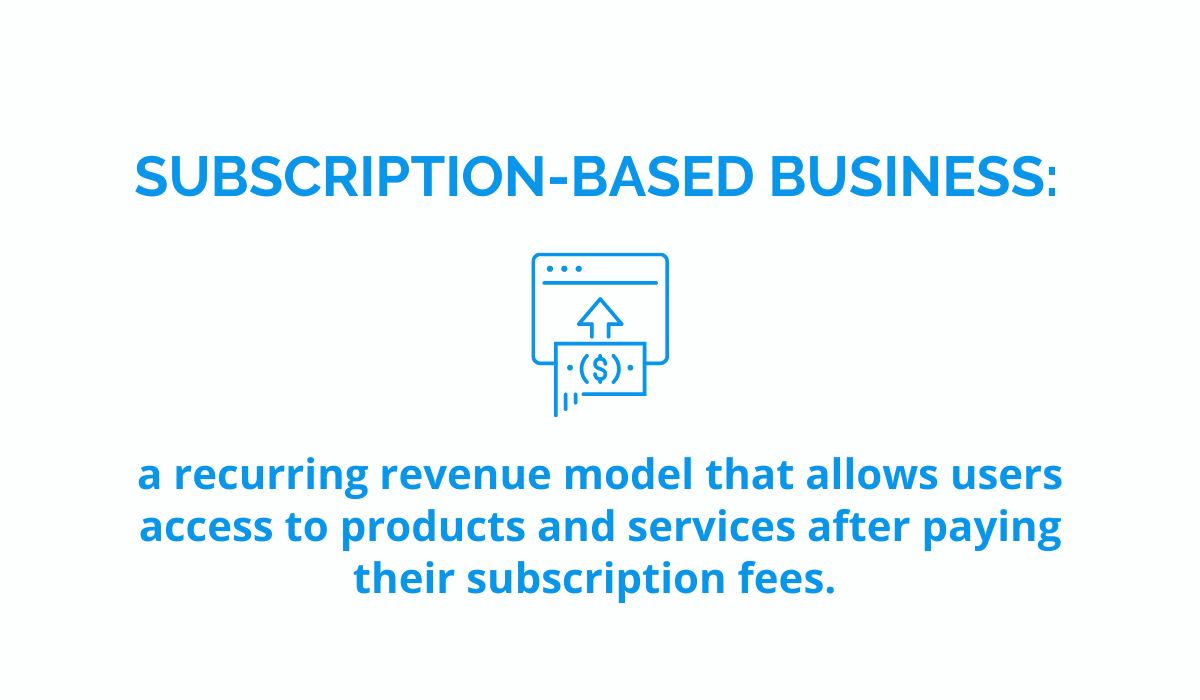
The “subscription-based economy” is revolutionizing the standard business practice.
Almost 70% of CEOs think that subscription models will be the leading business models in their respective industries.
Technological advances have made the process even easier for everyone to create or use subscription-based products, so it’s no surprise that by 2025 this business model will generate $10.5 billion with a growth rate of 15.5% between 2019 and 2025.
Subscriptions are here to stay, mainly because their reliability has made our daily routines easier and more manageable.
A Few Popular Saas Revenue Models
Adopting the right revenue model is the most important decision you can make for your business.
You need to find a structure that will help you garner more money and appeal to your customers.
Set your prices in a way that exceeds your customer’s expectations for quicker product adoption and keep your business profitable for years to come.
The Freemium Subscription Model
With the freemium model, customers use the application for free, for as long as they like.
Those who choose this model will never be charged for their use, but they’ll only have a limited amount of available features.
The freemium model is usually a part of tiered pricing, and companies use it to hook their users into trying out their product. If they’re satisfied, the users can upgrade to a paid model.
The typical tactic is to encourage users to get a paid plan if they try to interact with features not available in the freemium model (e.g., exceeding the limit on articles they can view, more storage, removing ads, etc.).
This model comes with its benefits and drawbacks.
Benefits:
- Initial Adoption – easy to start with a product
- User Referrals – if your product is good, then it has the potential to reach a wide range of customers
Drawbacks:
- No Revenue – because users don’t pay for the service, your costs are higher, and income plummets.
- Higher Churn Rates – because there is little commitment involved, free users are more likely to churn. Most of them are only testing out your product, and if they don’t find it helpful, they leave quickly.
- Product Devaluation – if you have a high-quality product that solves complex problems for free, users will be difficult to convince to pay for the service.
Here is an example of a freemium model by Airtable.
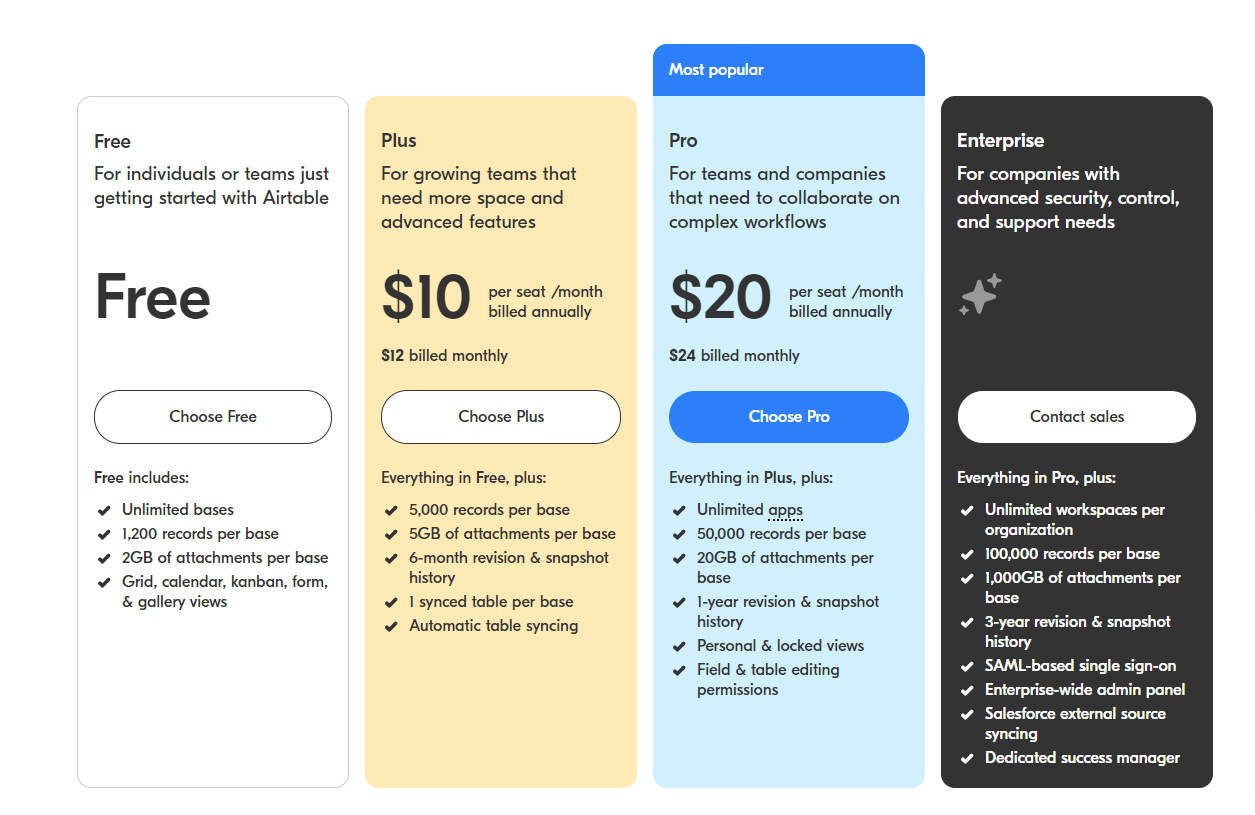
Freemium models are helpful for SMBs or startups to try a service before paying for it.
Most of them have scarce funds to pay for expensive SaaS solutions right away, so they’ll be most satisfied with free software with limited features.
Flat Rate Pricing
Flat rate pricing is similar to traditional software licenses, where you pay a single price for one set of features in a single product.
Charging a flat rate is the simplest pricing model in SaaS.
The added benefit to SaaS is that you pay for a singular set of features of a product on a flexible monthly or annual basis without worry about the price increase.
You get what you pay for, and there is no hidden sales strategy to get you to upgrade to a higher tier. Like other models, it also has its ups and downs.
Benefits:
- Clear Sales Strategy – your sales team has a clear offer for all your customers.
- Easy-to-Understand Pricing – any type of customer can understand flat rate pricing, and they’re not taken by surprise with hidden costs for additional features they don’t need
Drawbacks:
- Same Price for All Customers – you can sell to your target market, but you can miss out on potential revenue increase if customers with higher budgets (i.e., enterprise companies) want to use your product.
- No Room to Negotiate – with flat rate pricing you have to hook them from the start because you don’t have any other pricing or added benefits you can tempt them with. If they like it, they’ll take it. If they don’t, then they won’t, and you can’t change their minds.
This model is relatively rarely used nowadays since it doesn’t offer a lot of scaling in revenue.
Still, customers can benefit from a fixed price since it makes budgeting much easier—on the other hand, growing businesses might waste money on features they don’t use.
Usage-Based Model
This pricing strategy is very straightforward: how much you use the service, that’s how much you’ll pay.
If you use it less for one month, then your bill will go down, and if you exceed your average use, then your price will go up as well.
This model is useful for businesses with a predictable usage pattern who only have to pay for the services they use.
Such pricing is most common with infrastructure and platform-related SaaS, where companies charge based on data used, number of transactions, processed requests, etc.
While some companies are trying to adapt this model to their products and user base, it’s better to scrutinize it because of the numerous pros for the user, and challenging cons.
Benefits:
- The Price Matches the Usage Volume – why would you pay the same fee for a service if your usage is different every month? Sometimes you use it less, sometimes more, and, logically, you pay accordingly to use the service.
- Lower Use Barriers – customers can start with your product knowing that the price will only increase if their usage increases, so there’s no high up-front cost.
- Covering Heavy User Costs – if you have a fixed price, there’s a chance heavy users will take advantage of your resources and cost you more than they bring in. With the usage-based model, you can cover their increased usage with matching prices.
Drawbacks:
- Unpredictable Revenue – the customer’s billing will vary from month to month, making it harder to predict revenue.
- Unpredictable Costs – users with different usage patterns might have unexpected changes in their monthly bills
Here is an example of a SaaS company called SentryKit, which has a usage-based model.
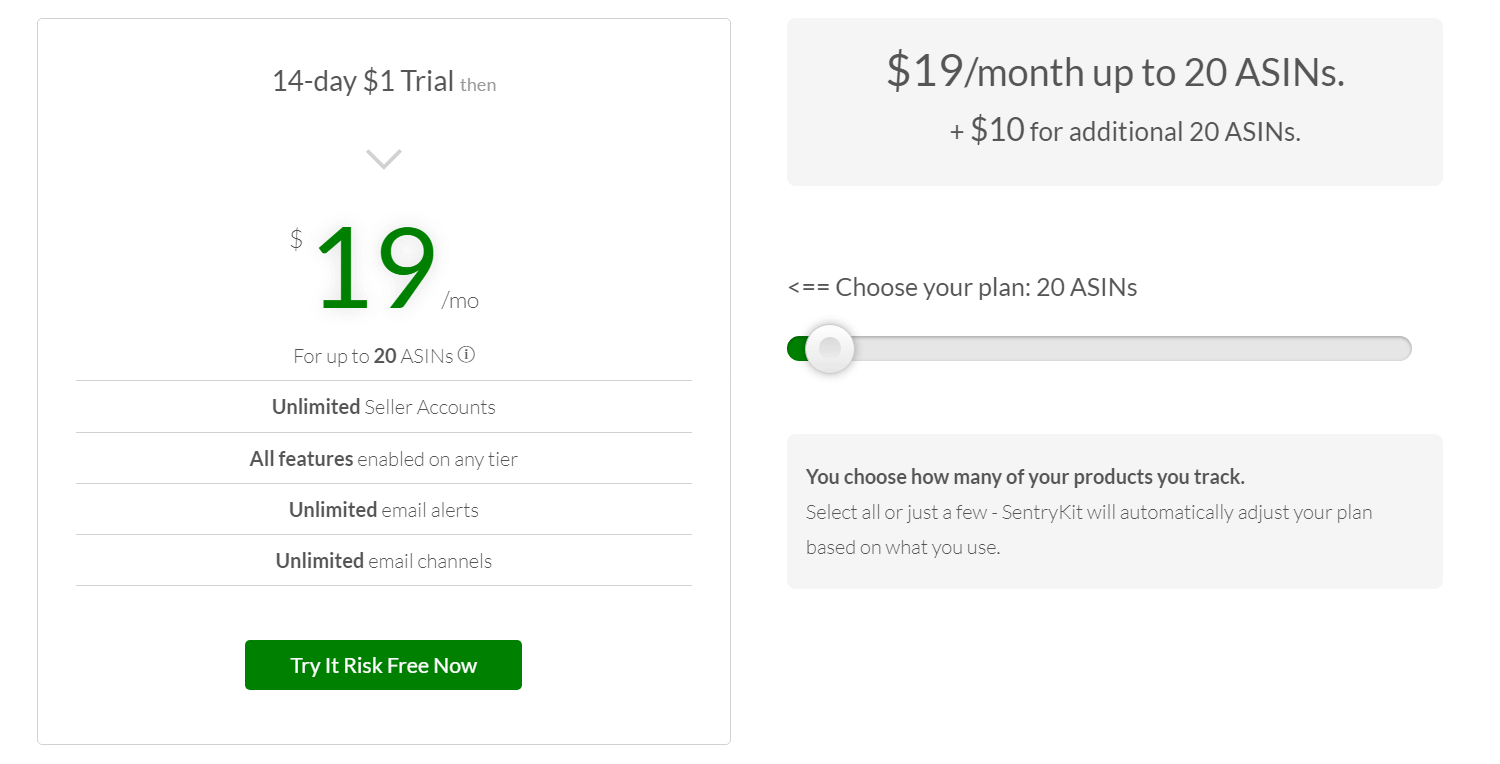
This pricing strategy is the least predictable—when predictability is normally the main benefit of the SaaS business model.
Take everything into consideration before you decide if this is a suitable model for you.
The costs might be higher than you expect, so only go for it if you are sure that your product is designed in a way that will allow you to benefit from this pricing strategy.
Per-User Pricing
Per-user pricing is the most popular in B2B SaaS. A company only has to pay a fixed price for the number of employees who use that product.
Small businesses can benefit from this pricing since they typically have a small number of employees, and the cost isn’t so high. Plus, they get all the SaaS features they need.
Another type of per-user pricing is per active user pricing.
Enterprises use this model because they can sign up many employees to use this model but only pay for those who actively use the product. It’s helpful to companies with a larger employee turnover, so they only pay for active accounts, which reduces costs significantly.
Let’s see the pros and cons of each type.
Benefits of Per-User Pricing:
- Direct Pricing Model – it’s pretty simple for customers to calculate monthly costs, and it makes the sales process easy.
- Revenue Scaling – as your customer base grows, it’s likely that revenue will grow with them as more employees adopt your product.
Drawbacks of Per-User Pricing:
- Limited Adoption – because you raise prices per user, companies might be reluctant to add new users. Also, they might even reuse a single account for multiple users.
- Churn – customers are more likely to churn if you limit adoption
Now let’s compare that to per active user pricing.
Benefits of Per Active User Pricing:
- Clients Pay for Active Users – for larger companies, it’s more cost-effective if they’re billed for employees who use the products than everyone who works at the company.
- It’s Easier to Test New Products – when they consider new SaaS products, companies can test out if their employees will adopt a particular product. If not, they’re not paying for it and can easily switch to something else.
Drawbacks of Per Active User Pricing:
- Useless for SMBs – while enterprises can benefit from this model, smaller companies have less money to spend, and their teams are usually smaller. It often doesn’t make sense to spend more when there are other more affordable pricing models.
Here is an example of per-user pricing offered by Monday.com.
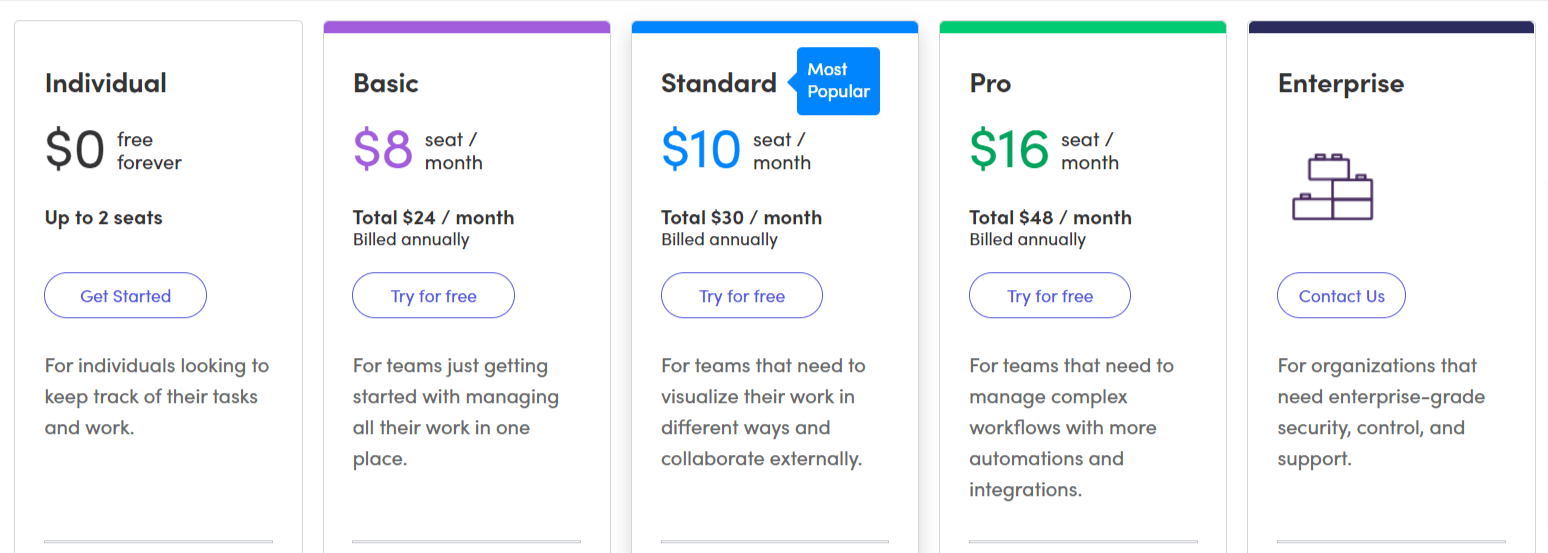
Let’s look at one more pricing model.
Tiered Revenue Model
Tiered pricing is the most popular and the most familiar model.
Most companies use it, and it consists of different packages where you pay a certain price for a specific set of features.
The logic is that the higher the price, the more features you’re allowed to use. The tiered pricing model combines the convenience of choice and general affordability.
Each tier is designed for a different customer in mind, and varying subscription costs can drive more customers into the funnel.
Its main perk is flexibility, so users can upgrade and downgrade as much as they like.
One helpful tip is that while the number of features and tiers can vary, most SaaS companies should stick to 3 or 4. More than that can lead to analysis paralysis in users.
Benefits of the Tiered Model:
- Different Types of Customers – with the tiered model you can cater to a wide variety of customers. Those who are your target market, and even those who might be out of that range.
- Different Budgets – customers will likely have different budgets, so you can target those on the lower spectrum and those who are willing to pay more. In this way, you can control if you overcharge or undercharge your customers.
- Upselling Opportunities – customers can easily upgrade their plans once they see more value in your product.
Drawbacks of the Tiered Model:
- Too Many Choices – customers might be confused about what they get with each plan, and having too many options might force them to leave.
- Overexertion – in the effort to generate more leads and appeal to the widest market, it’s tempting to offer as many packages as you can, but you can’t please everyone.
- Limited Expansion – if your heavy users frequently go overboard with their use of the service, you can’t negotiate and collect the extra revenue.
Even though tiered pricing is the most used pricing model, carefully consider all the drawbacks and benefits.
Here’s an example of a simple tiered model used by Adobe.
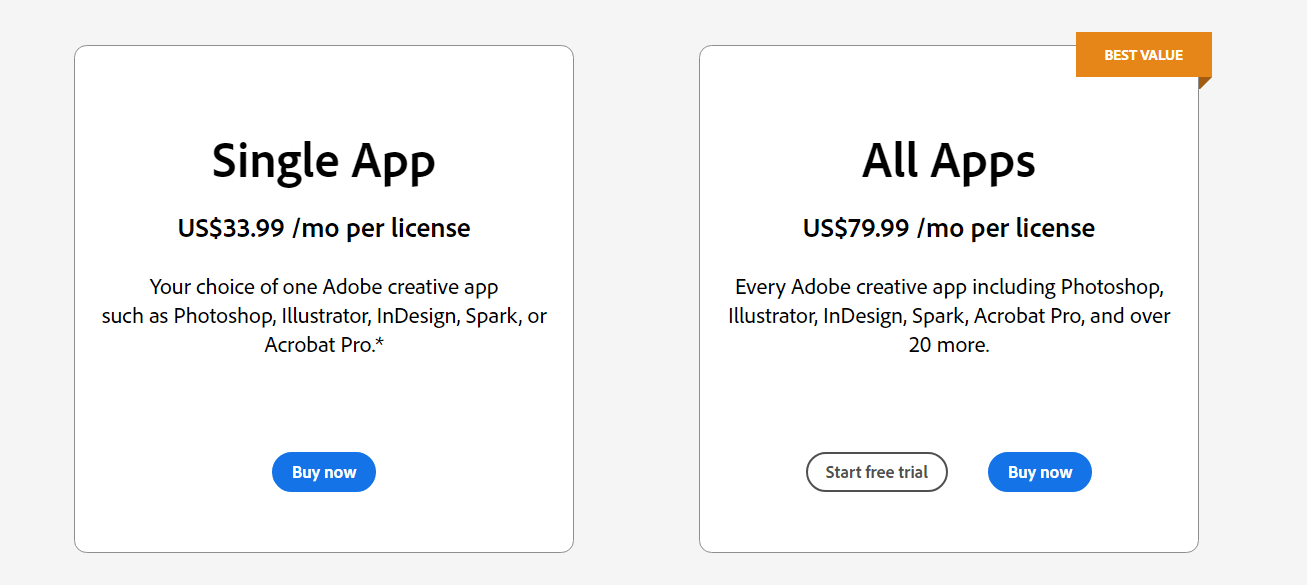
Or a multitiered model offered by ScraperApi.
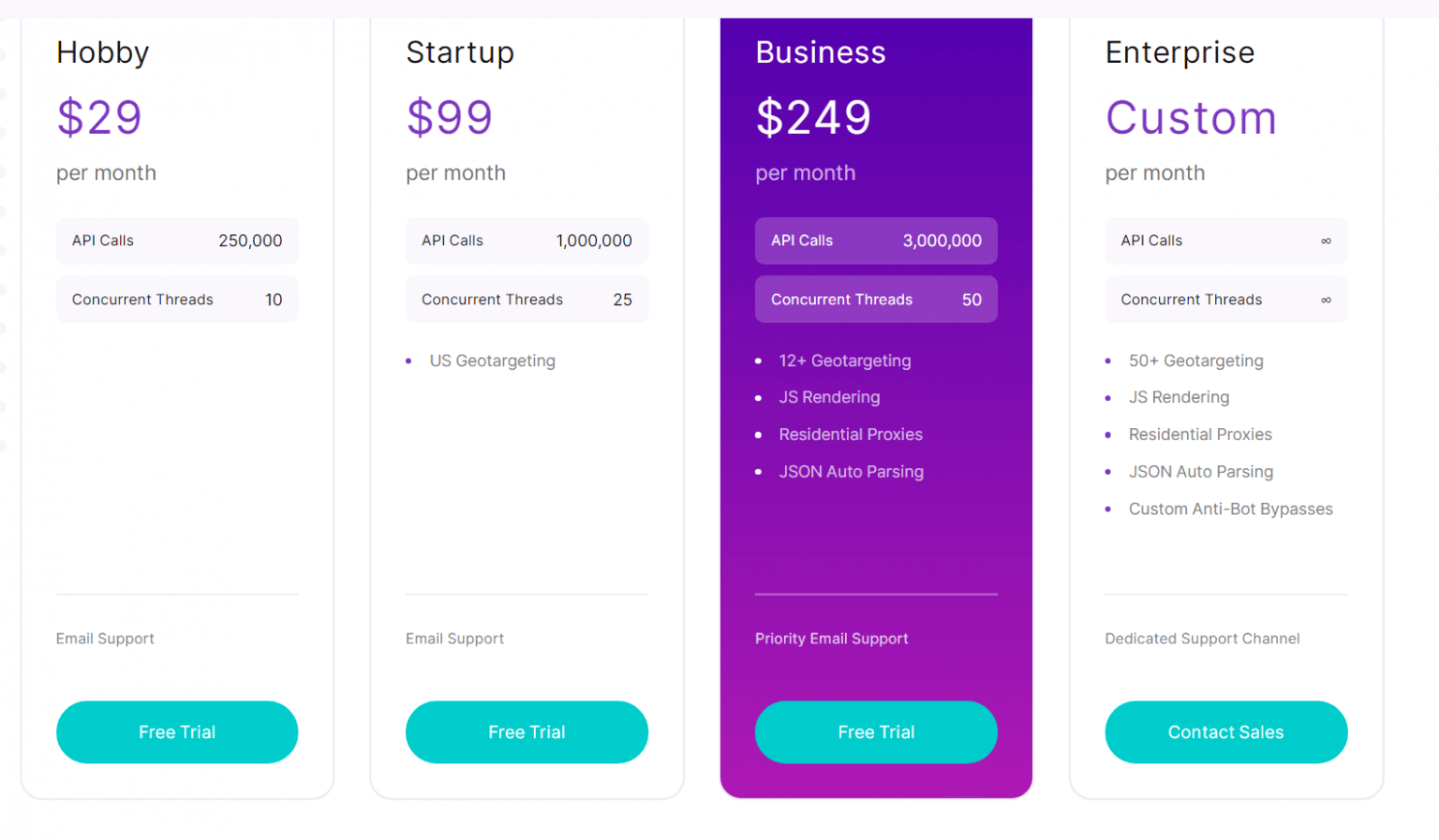
However, there are other ways for SaaS companies to generate revenue.
Other Ways SaaS Companies Can Make Money
Subscriptions are the base income stream for your business.
But if you’re not taking advantage of other ways of making money, you’re seriously missing out on incredible opportunities to grow your business.
Upselling is a no-brainer, but here are some routes you probably didn’t consider.
Affiliate Sales
Sometimes word of mouth can be a good way to acquire more customers.
With this approach, you generate sales indirectly through affiliates. They are your brand promoters, and they build awareness of your business.
The best affiliates are the customers you already have since they’re familiar with your product and they can accurately bring out benefits to other potential customers who need a solution you’re offering.
Hearing a recommendation from a friend makes new customers more likely to trust your company as well.
A great bonus for your affiliate program includes a commission that further motivates your affiliates to spread a good word about your product.
Here’s an example of an affiliate program by Convert Kit.
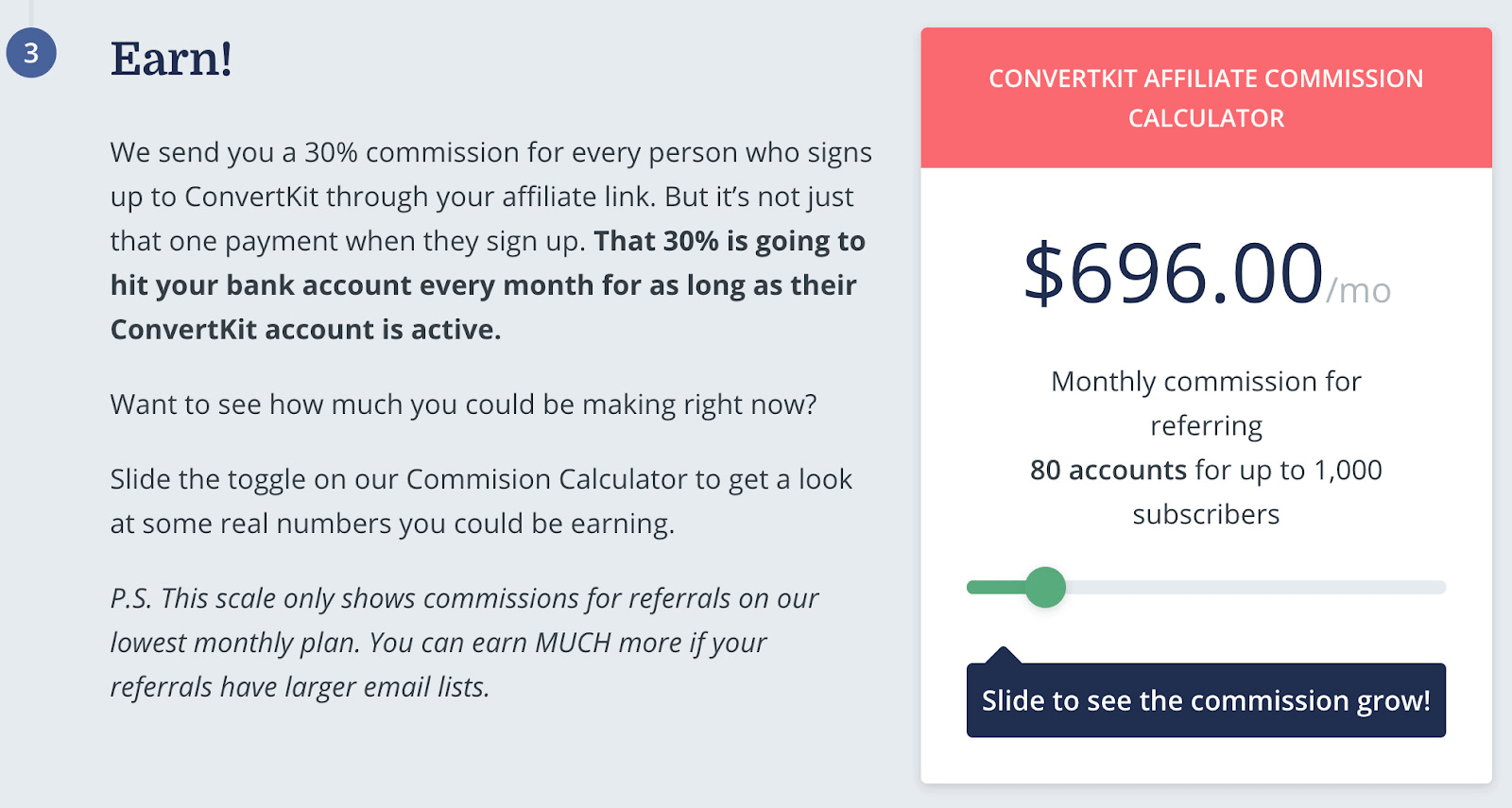
With affiliate marketing tools, you can lower your marketing costs, grow into other markets and reach new customers.
It can also help you retain customers because they’re encouraged to promote your product.
APIs
API means application program interface, and it’s usually used for SaaS products that can work with other software.
You’re making a huge mistake if you stick to your core product without considering how it can be integrated with other available software or competitors’ products.
Some benefits to APIs are:
- expanded customer reach
- increased sales, and marketing
- business scaling
- innovation stimulation.
Startups can benefit from this if they combine their business with others. However, be careful: APIs can be pretty expensive, and they might not pay off in the long run. Ahrefs software is one example using APIs as an added revenue stream.
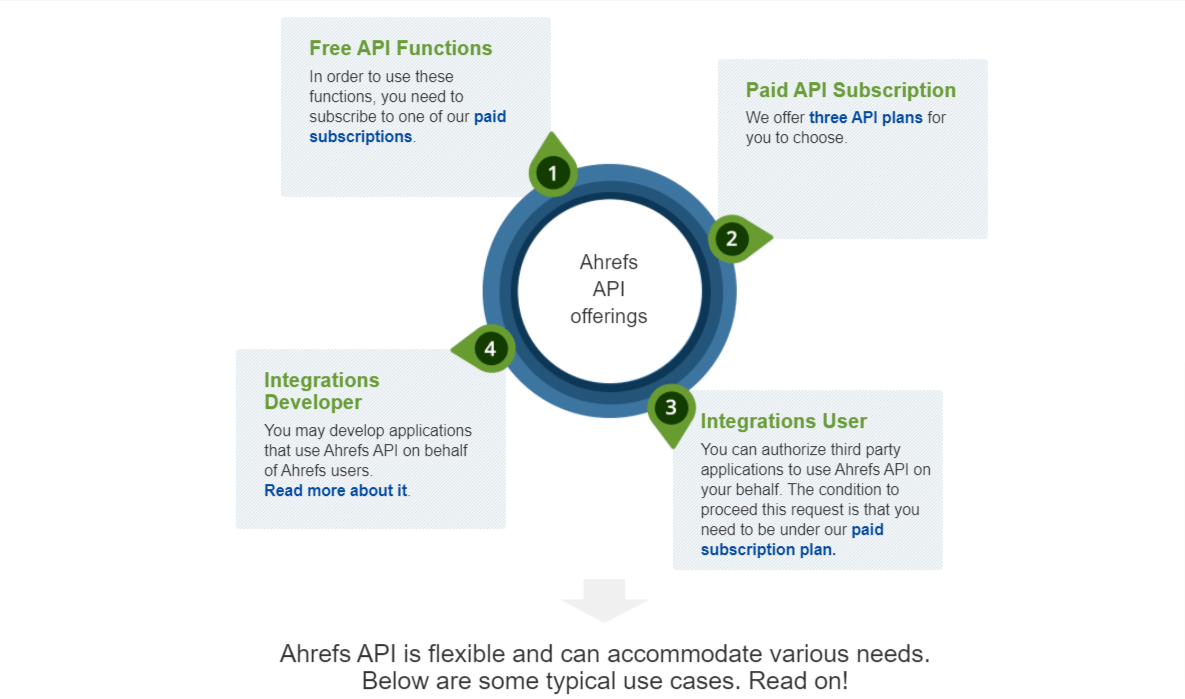
Easy integration with other applications can help you scale faster, promote innovation and reach new markets.
Advertising
It’s one of the most manageable additional revenue streams, and it doesn’t require much work on your part.
By leaving space for ads in your SaaS product, you can quickly make up for any loss of revenue from your freemium users or trial users.
However, it also has some significant drawbacks.
Customers are sensitive to ads, and if you overrun your product with them, they might never want to use it again.
Ads only work in freemium models, so you should avoid them in paid ones.
If your customers are already paying a lot to use your product, you shouldn’t bother them with annoying ads that might cause them to churn.
Here’s how Spotify includes ads in freemium accounts.

Such ads do not appear in the upgraded version.
White Label Licensing
White labeling is selling your software solution to others to be rebranded and resold to new customers.
The key feature of this income stream is anonymity since the end-users usually don’t recognize that the ‘new’ product is originally produced by another company than the one they bought it from.
White labeling can help you expand your product offerings.
You can scale more efficiently by providing more products and attracting customers who need solutions for more complex problems.
Here’s a simple look at how white labels work:
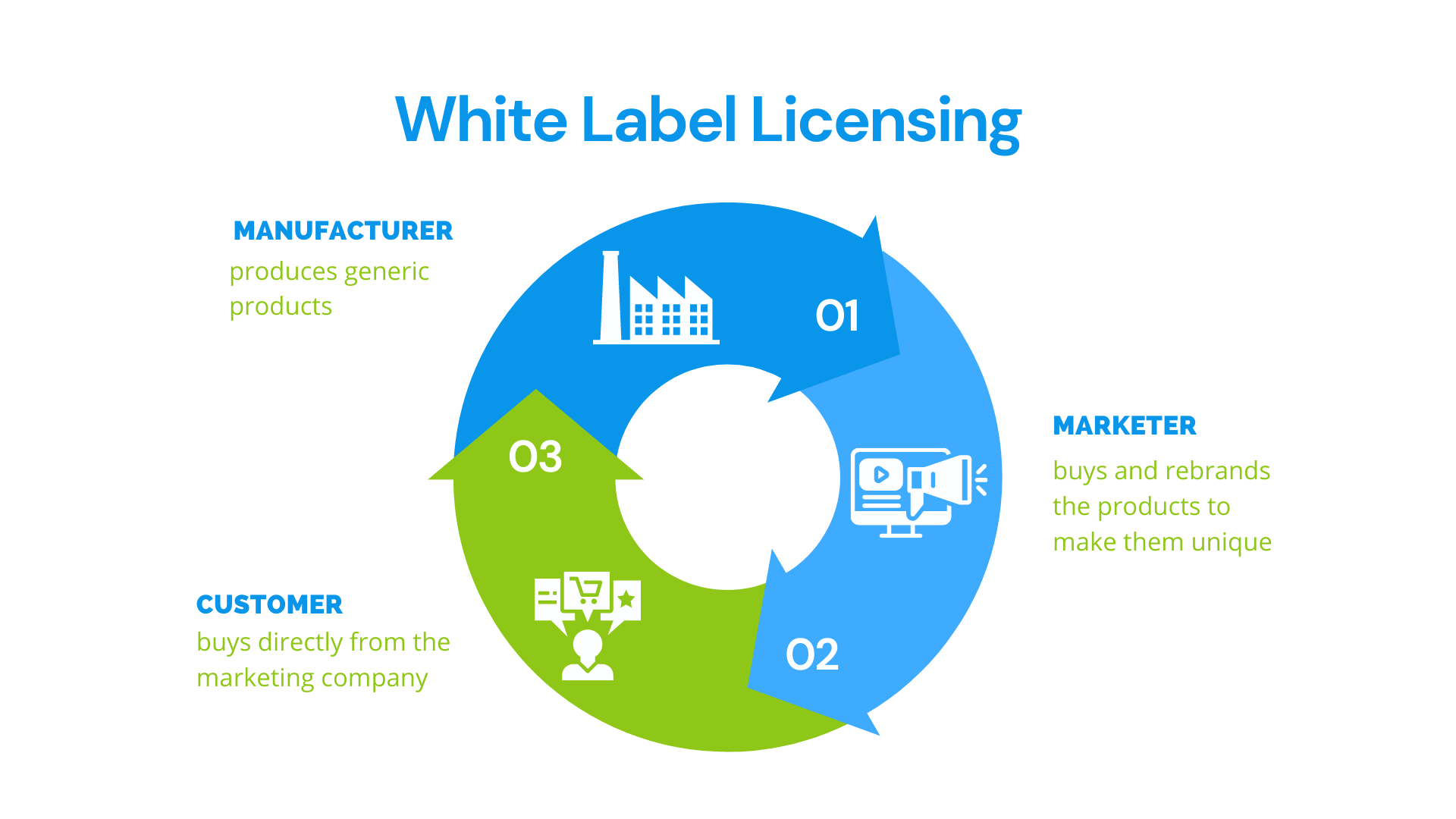
Resellers have the unique opportunity to quickly start a business and earn an additional profit without worrying about the production cost.
On the other hand, the original seller benefits from promoting their product without extra marketing costs.
Nevertheless, some significant drawbacks include being at the mercy of the resellers and their ability to sell the products as you intended.
They might lower the prices or are unable to reach a broader scope of customers.
Before you sell your product under a white label, you must consider all the risks and benefits of this approach.
Tips for Making Money as a SaaS Company
Your product is your main point of recurring revenue, so it’s reasonable that it makes you the most money.
Taking a risk with other income streams might not be the best solution for everyone, so here are some other things you can do to acquire more customers and make more money.
Acquire More Users With a Better Experience
Nowadays, it’s not the product that sells; it’s the experience.
In trying to keep up with the users’ ever-growing needs and expectations, you must focus on aspects of your product that will make them stay loyal to you.
The first of them is onboarding. We’ve covered some excellent onboarding practices, but the gist of it all is to make the experience frictionless and motivating.
According to a Forbes Insights report, 55% of customers say that firsthand experience was essential to them when they formed an opinion of a brand.
Taking that into account, user experience during onboarding should be enjoyable and straightforward: from the sign-up to the first walkthrough and experiencing their Aha! Moment.
This will help you retain users and acquire new ones.
Streamline the User Billing Process
Failed payments are one of the most common problems in the SaaS business.
One way to cope with hard or soft declines is using a recurring billing system.
Once your customers provide necessary data, they’re automatically billed (weekly, monthly, annually) based on their subscription plan.
This process is also a part of the user experience, so if it’s too complicated and confusing, you’re potentially losing thousands of potential new customers.
With recurring billing, the number of failed payments (which can lead to churn) is drastically reduced since the model operates as an automated service with triggered transactional emails.
These include invoices, dunning emails, etc.
RegPack has developed a secure and reliable billing system that will help your visitors become customers. You will also benefit from a simple automated process that will save you time.
Prepare for Scaling in Advance
No business model has the same level of consistency as SaaS does. The subscription-based model is blessed by revenue predictability and easily-tracked changes in business growth.
Every SaaS company should benefit from the abundance of data they can gather from their customers.
Data is what drives business growth, and correctly analyzing it can quickly scale your business.
We’ve already covered ten key metrics SaaS businesses should track for reporting.
The beauty of SaaS metrics is that you don’t have to wait years to know if a strategy worked.
Your business decisions impact your revenue in a matter of months, and you can easily change strategies according to your needs.
Carefully tracking important metrics (such as MRR and churn rates) can help you manage your growing user base and adjust to the changing market.
Change Pricing When Needed
Another great thing about SaaS is that you can change things about your business according to your users’ needs, even daily if you track your metrics in the right way.
Since almost everything in SaaS is highly flexible and customizable, so is the pricing for those services.
To reduce churn rates or for better marketing strategies, you can re-evaluate your prices as you go.
Through careful market research, you can predict when to raise prices or offer discounts to refine your product offer.
As you update and improve your product, you should charge for it accordingly.
You don’t want to undersell something that solves complex problems for your customers and cause frustration once you raise your prices, but you also don’t want to oversell a simple product and make them turn to your competitors.
Pricing should be strategic, and you should always do what’s best for your company and your customers.
Conclusion
More and more companies are seeing the benefits of the subscription-based model.
It will undoubtedly impact how we do business in the future—both from the consumer’s perspective and that of the company.
How you make money depends on successfully implementing the right strategy.
While some businesses flourish with usage-based models and per-user pricing, the most popular one is still the tiered revenue model.
Companies should not neglect other ways to garner more revenue, especially with advertising (if they opt for a freemium model), affiliate sales, and APIs.
White labeling might not be for everyone, but it’s still a method worth considering.
Furthermore, some valuable tips in scaling are fundamental and do not require much fuss if you’re a business-savvy person.
Simply tracking your metrics, changing prices, and automating your billing process can tremendously help grow any SaaS business.


















